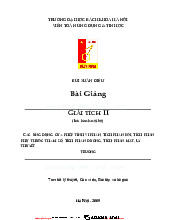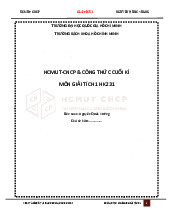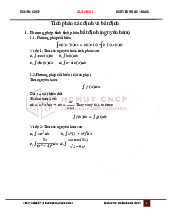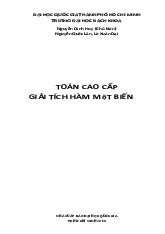









Preview text:
Phan Xuân Thành
School of Applied Mathematics and Informatics - HUST
Calculus 1 Exercise sheets –
Functions, essential functions
1. Determine the domain of a) 𝑦 = 𝑥 c) 𝑦 = ln 1−𝑥 𝑦 = √arctan 𝑥 √4𝑥2 b) 𝑦 = arcsin 2𝑥 −1 𝑥+1 d) . 1+𝑥
2. Find the range of the functions a) 𝑦 = l (
n 1 − 2 cos 𝑥) b) 𝑦 = arctan(𝑒𝑥) c) 𝑦 = √arccos 𝑥 d) 𝑦 = 𝑥2−1. 𝑥2+1
3. As dry air moves upward, it expands and cools. The ground temperature is 20°𝐶 and the
temperature at a height of 1 𝑘𝑚 is 10°𝐶.
a) Express the temperature 𝑇 (in °𝐶) as a function of the height ℎ (in kilometers), assuming that a linear model is appropriate.
b) Draw the graph of the function.
c) What is the temperature at a height of 4 𝑘𝑚?
4. The figure shown here shows a rectangle inscribed in an isosceles right triangle whose hypotenuse is 2 units long.
a) Express the 𝑦-coordinate of 𝑃 in terms of 𝑥. b) Express the area of the rectangle in terms of 𝑥.
5. Determine whether 𝑓 is even, odd, or neither
a) 𝑓(𝑥) = 𝑒𝑥−𝑒−𝑥 =: sinh 𝑥 b) 𝑓(𝑥) = 2𝑥−𝑥2 2 2𝑥+𝑥2
c) 𝑓(𝑥) = ln(𝑥 + √𝑥2 + 1) d) 𝑓(𝑥) = ln 1−𝑥
e) 𝑓(𝑥) = sin 𝑥 + cos 𝑥. 1+𝑥
6. Find the functions 𝑓 ∘ 𝑔, 𝑔 ∘ 𝑓, 𝑓 ∘ 𝑓, and 𝑔 ∘ 𝑔 and their domains a) 𝑓(𝑥) = 1 𝑔(𝑥) = 𝑥 − 1 b) 𝑓(𝑥) = √2𝑥 + 3 𝑔(𝑥) = 𝑥2 + 1. 𝑥+1 c) 𝑓(𝑥) = sin 𝑥 𝑔(𝑥) = √𝑥 + 1 d) 𝑓(𝑥) = 1 − 𝑥2 𝑔(𝑥) = 1−𝑥. 1+𝑥
7. Find the inverse functions of a) 𝑦 = 2 arcsin 𝑥
b) 𝑦 = 𝑒𝑥−𝑒−𝑥 c) 𝑦 = 1−𝑥 d) 𝑦 = ln 𝑒𝑥−1 2 1+𝑥 𝑒𝑥+1 1 Phan Xuân Thành
School of Applied Mathematics and Informatics - HUST Limits and Continuity
8. Find the limit of the following sequences (if it exists) 3
a) 𝑢𝑛 = √𝑛3 + 2𝑛2 − 𝑛
b) 𝑢𝑛 = tan ( 2𝑛𝜋 ) c) 𝑢 ) 1+8𝑛 𝑛 = cos (𝑛𝜋2 𝑛
d) 𝑢𝑛 = 𝑛 + 𝑛 + ⋯ + 𝑛 e) 𝑢 ) f) 𝑢 𝑛2+1 𝑛2+2 𝑛2+𝑛 𝑛 = (1 − 12𝑛 𝑛 = 𝑛 cos(𝑛2+1) 𝑛2+2
9. Find the limit of the sequence {√2, √2 + √2, √2 + √2 + √2, … }.
10. Evaluate the limits √𝑥2+8−3 tan 𝑥−sin 𝑥 9𝑥−5𝑥 𝑥6−1 ln(1+2𝑥2) a) lim b) lim e) lim 𝑥→1 𝑥−1 𝑥→0 𝑥3 c) lim 𝑥→0 4𝑥−3𝑥 d) lim 𝑥→1 𝑥10−1 𝑥→0 1−cos 𝑥 2𝑥 𝑥 ln(1+3 tan 𝑥) √𝑥5 f) lim (𝑥+1 ) g) lim (sin 1 + cos 1 ) h) lim i) lim . 𝑥→∞ 𝑥+3 𝑥→∞ 𝑥 𝑥 𝑥→0 𝑒𝑥−cos 𝑥
𝑥→0+ √sin 𝑥 ln(1−3𝑥2) 𝑓(𝑥)−8 11. If lim = 9, find lim 𝑓(𝑥). 𝑥→1 𝑥−1 𝑥→1 if
12. For what value of 𝑎 is 𝑓(𝑥) = { 𝑥2 + 2, 𝑥 < 1
2𝑎𝑥3 + 1, i f 𝑥 ≥ 1 continuous at every 𝑥?
13. Show that 𝑓 is continuous on (−∞, ∞). sin 𝑥 i f 𝑥 < 𝜋 a) 𝑓(𝑥) = { 4 cos 𝑥 i f 𝑥 ≥ 𝜋
b) 𝑓(𝑥) = {𝑥2 if 𝑥 < 1 √𝑥 if 𝑥 ≥ 1 4
14. Locate the discontinuity of the function and illustrate by graphing sin 𝑥 a) 𝑦 = 1 ln 2 𝑥) c) 𝑦 = 1+𝑒1/𝑥 b) 𝑦 = (tan 2𝑥 −1
15. Find the numbers at which 𝑓 is discontinuous. At which of these numbers is 𝑓 continuous from
the right, from the left, or neither? 2𝑥−1 if 𝑥 < 0 sin2(𝜋𝑥) i f 𝑥 < 1 a) 𝑓(𝑥) = { 𝑥 b) 𝑓(𝑥) = {ln(1+2𝑥2) 2𝑥 + 𝑐 if 𝑥 ≥ 0 √𝑥 if 𝑥 ≥ 1
16. Prove that there is a root of the given equation in the specified interval.
a) 𝑥6 − 3𝑥 + 1 = 0, (0, 1)
b) 𝑥3 = √3𝑥 + 1, (1, 2).
17. A train starts at 8AM from Hanoi to Haiphong, arriving at 11AM. The next day it starts at 8AM
from Haiphong to Hanoi, arriving at 11AM. Is there a point on the route the train will cross at exactly
the same time of day on both days?
18. Let 𝑓 be a continuous function on a close interval [0, 1] and 𝑓(0) = 1, 𝑓(1) = 0. Prove that there
is a number 𝑐 ∈ (0, 1) at which 𝑓(𝑐) = 𝑐. 2 Phan Xuân Thành
School of Applied Mathematics and Informatics - HUST Derivatives
19. Find the derivative of the function 3
a) 𝑦 = (𝑥2 + 1)√𝑥2 + 2 b) 𝑦 = sin(tan 𝑥) c) 𝑦 = √𝑥 + √𝑥 1 𝑥 d) 𝑦 = l ( n 𝑥 + √𝑥2 + 5)
e) 𝑦 = sin𝑛 𝑥 cos 𝑛𝑥 f) 𝑦 = (1 + ) 𝑥 20. Fi d
n equations of the tangent line and the normal line to the curve
a) 𝑦 = ln(𝑥 + √𝑥2 + 3) at 𝑥 = 1
b) 𝑦 = 𝑥 + tanh(2𝑥) at 𝑥 = 0.
21. Find a cubic function 𝑦 = 𝑎𝑥3 + 𝑏𝑥2 + 𝑐𝑥 + 𝑑 whose graph has horizontal tangents at the points (−2, 6) and (2, 0).
22. Find the points on the curve 𝑦 = 2𝑥3 − 3𝑥2 − 12𝑥 + 20 where the tangent is
a) perpendicular to the line 𝑦 = 1 − 𝑥
b) parallel to the line 𝑦 = √2 − 12𝑥 24
23. Show that the tangents to the curve 𝑦 = 𝜋 sin𝑥 at 𝑥 = 𝜋 and 𝑥 = −𝜋 intersect at right angles. 𝑥
24. For what values of 𝑎 and 𝑏 will 𝑓(𝑥) = { 𝑎𝑥 𝑖𝑓 𝑥 < 2
𝑎𝑥2 + 𝑏𝑥 + 3 𝑖𝑓 𝑥 ≥ 2
be differentiable for all values of 𝑥? Discuss the geometry of the resulting graph of 𝑓.
25. Let 𝑓(𝑥) = {𝑥2 if 𝑥 ≤ 2
𝑚𝑥 + 𝑏 i f𝑥 > 2 . Find the values of 𝑚 and 𝑏 that make 𝑓 differentiable everywhere.
26. Let 𝑟(𝑥) = 𝑓(𝑔(ℎ(𝑥))), where ℎ(1) = 2, 𝑔(2) = 3, ℎ′(1) = 4, 𝑔′(2) = 5, and 𝑓′(3) = 6. Find 𝑟′(1).
27. Is the derivative of
ℎ(𝑥) = {𝑥2 sin(1/𝑥) 𝑖𝑓 𝑥 ≠ 0 0 𝑖𝑓 𝑥 = 0
continuous at 𝑥 = 0? How about the derivative of 𝑘(𝑥) = 𝑥ℎ(𝑥)? Give reasons for your answer.
28. Find the nth derivatives of the function a) 𝑦 = 1 b) 𝑦 = 𝑥 𝑥2+𝑥
c) 𝑦 = (𝑥2 + 1)𝑒2𝑥 𝑥2−4 d) 𝑦 = l ( n 2𝑥2 + 𝑥)
e) 𝑦 = (2𝑥 + 1) cos 3𝑥.
29. a) Given 𝑓(𝑥) = ln 𝑥+1, find 𝑑𝑓(𝑥), 𝑑10𝑓(𝑥). 𝑥+2
b) Given 𝑓(𝑥) = (𝑥 + 2) ln 𝑥, find 𝑑2𝑓(1), 𝑑20𝑓(1). 3 Phan Xuân Thành
School of Applied Mathematics and Informatics - HUST
30. If 𝑓 and 𝑔 are differentiable functions with 𝑓(0) = 𝑔(0) = 0 and 𝑔′(0) ≠ 0, show that 𝑓(𝑥) 𝑓′(0) lim
𝑥→0 𝑔(𝑥) = 𝑔′(0).
31. Prove each of the following.
a) The derivative of an even function is an odd function.
b) The derivative of an odd function is an even function. 𝑖𝑓 𝑥 ≠ 0,
32. Find the derivative of the function 𝑓(𝑥) = {𝑥 arctan 1𝑥2 0 𝑖𝑓 𝑥 = 0.
33. Suppose that the functions 𝑓 and 𝑔 are defined throughout an open interval containing the points
𝑥0, that 𝑓 is differentiable at 𝑥0, that 𝑓(𝑥0) = 0, and that 𝑔 is continuous at 𝑥0. Show that the product
𝑓𝑔 is differentiable at 𝑥 . 0
34. If 𝐹(𝑥) = 𝑓(3𝑓(4𝑓(𝑥))), where 𝑓(0) = 0 and 𝑓′(0) = 2, find 𝐹′(0). 4 Phan Xuân Thành
School of Applied Mathematics and Informatics - HUST
Applications of derivatives
35. Evaluate the following limits arcsin 𝑥−𝑥 𝑥5−ln(1+𝑥5) a) lim c) lim 𝑥 ln |𝑥|
d) lim 𝑥[𝜋 − 2 arctan(3𝑥)] 𝑥→0 𝑥3 b) lim 𝑥→0 sin10 𝑥 𝑥→0 𝑥→+∞ 1
e) lim( 𝑥 − 1 ) f) lim (1 − 2 ) g) lim (𝑥2 + 2𝑥)1𝑥
h) lim[ln(𝑒 + 2𝑥)]sin𝑥 𝑥→1 𝑥−1 ln 𝑥 𝑥→0 𝑥 𝑒2𝑥−1 𝑥→−∞ 𝑥→0 1 sin 𝑥 ln(𝑥+1)−𝑥2
i) lim[2𝑥 + 𝑒3𝑥] sin𝑥 j) lim [arcsin 2𝑥]tan 𝑥 k) lim 𝑥→0 𝑥→0+ 𝑥→0 𝑥3 36. Show that
a) sin(arccos 𝑥) = cos(arcsin 𝑥) = √1 − 𝑥2 for all 𝑥 ∈ [−1, 1]. 1
b) arctan 2𝑥 = arctan 𝑥 for all 𝑥 ∈ (−1, 1).
c) arcsin(tanh 𝑥) = arctan(sinh 𝑥). 2 1−𝑥2 37. Prove that
a) |arcsin 𝑥 − arcsin 𝑦| ≥ |𝑥 − 𝑦| for all 𝑥, 𝑦 ∈ [−1, 1]. 𝑦−𝑥 b)
< arctan 𝑦 − arctan 𝑥 < 𝑦−𝑥 1+𝑦2 for all 0 < 𝑥 < 𝑦 1+𝑥2 . 1 𝑥
c) − 𝑥 < 1 − 1 < 1 for all 𝑥 > 0. d)
≤ ln(𝑥 + 1) ≤ 𝑥 for all 𝑥 > −1 2 8 𝑥 𝑒𝑥−1 2 . 𝑥+1
38. Show that the equation 3𝑥 + 2 cos 𝑥 + 5 = 0 has exactly one real root.
39. Show that the equation 𝑎 cos 𝑥 + 𝑏 cos 2𝑥 + 𝑐 cos 3𝑥 = 0 has at least one root on (0, 𝜋).
40. Suppose that 𝑓(𝑥) is a continuous function on a close interval [𝑎, 𝑏] and differentiable on (𝑎, 𝑏),
and 𝑓(𝑎) = 𝑓(𝑏) = 0. Show that there exists a number 𝑐 ∈ (𝑎, 𝑏) such that 𝑓′(𝑐) = 2021𝑓(𝑐).
41. For what values of 𝑎 and 𝑏 is the following equation true ? sin 2𝑥 lim( 𝑏 𝑥→0 𝑥3 + 𝑎 + 𝑥2) = 0.
42. Determine the local extreme values a) 𝑦 = 𝑥2/3(𝑥 + 2)
b) 𝑦 = 𝑥2/3(𝑥2 − 4) c) 𝑦 = 𝑥√4 − 𝑥2 d) 𝑦 = 𝑥2 ln 𝑥
e) 𝑦 = (𝑥2 − 3)𝑒𝑥
f) 𝑦 = 3 arctan 𝑥 − ln(𝑥2 + 1)
g) 𝑦 = ln(𝑥 + 3) + arccot 𝑥
43. Find the absolute maximum and minimum values of 𝑓(𝑥) = 𝑥2 + 250 over [1, 10]. 𝑥
44. What value of 𝑎 makes 𝑓(𝑥) = 𝑥2 + 𝑎 have 𝑥
a) a local minimum at 𝑥 = 2?
b) a point of inflection at 𝑥 = 1?
45. Find the intervals of concavity and the inflection points of
a) 𝑓(𝑥) = 𝑥2 ln 𝑥.
b) 𝑓(𝑥) = (𝑥 + 1)𝑒−𝑥
c) 𝑓(𝑥) = (1 − 𝑥)√ 3 𝑥. 5 Phan Xuân Thành
School of Applied Mathematics and Informatics - HUST
46. (The best fencing plan) A rectangular plot of farmland will be bounded on one side by a river
and on the other three sides by a singl -
e strand electric fence. With 800m of wire at your disposal,
what is the largest area you can enclose, and what are its dimensions?
47. Find the volume of the largest right circular cone that can be inscribed in a sphere of radius 3.
48. (Designing a can) What are the dimensions of the lightest open-top right circular cylindrical can
that will hold a volume of 1000 𝑐𝑚3.
49. A rectangle is to be inscribed under the arch of the curve 𝑦 = 4 cos(𝑥/2) from 𝑥 = −𝜋 to
𝑥 = 𝜋. What are the dimensions of the rectangle with largest area, and what is the largest area?
50. Find the dimensions of a right circular cylinder of maximum volume that can be inscribed in a
sphere of radius 10 cm. What is the maximum volume?
51. Find the nth-degree Taylor polynomials centered at 𝑥 = 0 of 𝑓(𝑥). Determine the remainder.
a) 𝑓(𝑥) = 𝑥 cos 𝑥, 𝑛 = 5. b) 𝑓(𝑥) = 𝑥 𝑛 = 5 √
c) 𝑓(𝑥) = √2 + 2𝑥 𝑛 = 3 1+𝑥2, , .
52. Determine the asymptotes of the graph of 𝑦 = 𝑓(𝑥) a) 𝑦 = 𝑒𝑥 b) 𝑦 = 𝑥 arccot 2 ( )𝑒1/𝑥 𝑥+1 c) 𝑦 = 𝑥 + 2 𝑥 3 d) 𝑦 = √𝑥3 + 𝑥 e) 𝑦 = 𝑒𝑥 ln 𝑥
53. Determine the asymptotes of the curves
a) 𝑥 = 𝑡3 − 3𝜋, 𝑦 = 𝑡3 − 6 arctan 𝑡
b) 𝑥 = 𝑡2 , 𝑦 = 𝑡 . 𝑡−1 𝑡2−1
54. If 𝑓′ is continuous, 𝑓(2) = 0, and 𝑓′(2) = 7, evaluate
𝑓(2 + 3𝑥) − 𝑓(2 + 5𝑥) lim 𝑥→0 𝑥 .
55. A rectangle is to be inscribed in a semicircle of radius 2. What is the largest area the rectangle
can have, and what are its dimensions?
56. What value of 𝑎 and 𝑏 make 𝑓(𝑥) = 𝑥3 + 𝑎𝑥2 + 𝑏𝑥 have
a) a local maximum at 𝑥 = −1 and a local minimum at 𝑥 = 3?
b) a local minimum at 𝑥 = 4 and a point of inflection at 𝑥 = 1? 6 Phan Xuân Thành
School of Applied Mathematics and Informatics - HUST Integrations
57. Evaluate the following integrals a) ∫ 𝑥3+1 𝑑𝑥 b) ∫ tan4 𝑥 𝑑𝑥 c) ∫ 1−2𝑥 𝑑𝑥 𝑥2+4 √ 2+𝑥2 𝑑𝑥 d) ∫ 𝑥 (𝑥2+1)(𝑥+2) e) ∫ sin2𝑥 𝑑𝑥 𝑑𝑥 √ f) ∫ 𝑑𝑥 . sin4 𝑥+1 g) ∫ 𝑑𝑥 3 sin 𝑥−4 cos 𝑥 1+√𝑥2 h) ∫ 𝑥+1 +4𝑥+5 √𝑥2−2𝑥−1
58. Evaluate the following integrals
a) ∫(𝑥 + 1) arctan 𝑥 𝑑𝑥
b) ∫(𝑥 + 2) ln 𝑥 𝑑𝑥 c) ∫ arcsin2 𝑥 𝑑𝑥 d) ∫ arctan𝑥 𝑑𝑥 e) ∫ 𝑥 𝑑𝑥 f) ∫ 𝑒2𝑥 𝑑𝑥 g) ∫ √ 𝑥 𝑑𝑥 𝑥2 (𝑥2+2𝑥+2)2 1+𝑒𝑥 𝑥−1 h) ∫ 𝑥2+2𝑑𝑥 i) ∫ 𝑥2+1 𝑑𝑥 j) ∫ sin2 𝑥 𝑑𝑥 k) ∫ 1 𝑑𝑥. 𝑥3−1 𝑥4+1 cos3 𝑥 𝑥2√𝑥2+1
59. Find a function 𝑓(𝑥) such that 𝑓′(𝑥) = 𝑥3 and the line 𝑥 + 𝑦 = 0 is tangent to the graph of 𝑓(𝑥).
60. A car is traveling at 100km/h when the driver sees an accident 80m ahead and slams on the
brakes. What constant deceleration is required to stop the car in time to avoid a pileup? 13 1 𝜋/6 61. Show that a) < ∫ sin(𝑥2) 𝑑𝑥 b) ∫ cos(𝑥2) 𝑑𝑥 . 42 0 < 13 0 > 12
62. Find the derivative of the following functions 𝑥 𝑥2 0
a) 𝑓(𝑥) = ∫ √1 + 𝑡4𝑑𝑡 0
b) 𝑔(𝑥) = ∫ sin(𝑡2) 𝑑𝑡 0
c) ℎ(𝑥) = ∫ sin3 𝑡 𝑑𝑡 𝑥3 .
63. Evaluate the limit by first recognizing the sum as a Riemann sum for a function defined on [0, 1]. 1 𝑛 a) lim ∑𝑛 𝑘4
(√1 + 1 + √1 + 2 + ⋯ + √1 + ). 𝑛→∞ 𝑘=1 b) lim 𝑛5 𝑛→∞ 𝑛 𝑛 𝑛 𝑛
64. Evaluate the following integrals 𝑒 𝜋/4 2 1 a) ∫ (𝑥 ln 𝑥)2𝑑𝑥 𝑑𝑥 𝑑𝑥 𝑑𝑥 1 b) ∫ sin2 𝑥 cos 𝑥 0 (1+tan2 𝑥)2 c) ∫ √𝑥2−1 1 𝑥2 d) ∫ ln(𝑥2+1) 0 . (𝑥+1)2
65. If 𝑓 is continuous on [0, 1], show that 𝜋/2 𝜋/2 𝜋 𝜋 a) ∫ 𝑓(sin 𝑥)𝑑𝑥 = 0 ∫ 𝑓(cos 𝑥)𝑑𝑥 0
b) ∫ 𝑥𝑓(sin 𝑥)𝑑𝑥 0
= 𝜋 ∫ 𝑓(sin 𝑥)𝑑𝑥 2 0 . 𝜋 3 𝜋/2 Evaluate c) ∫ 𝑥 sin𝑥 𝑑𝑥 0 1+cos2 𝑥 d) ∫ √sin 𝑥 0 . √ 3 sin𝑥 + √3 𝑑𝑥 cos 𝑥
66. Determine whether each integral is convergent or divergent. Evaluate those that are convergent. ∞ ∞ ∞ 0 1 a) ∫ 𝑥 𝑑𝑥 0 𝑑𝑥 𝑑𝑥 𝑑𝑥 ( b) ∫ 𝑥+2 𝑥2+2)2 1 c) ∫ 𝑥 𝑥2+3𝑥 −∞ d) ∫ 𝑥𝑒−𝑥𝑑𝑥 𝑥2+1 −∞ e) ∫ ln𝑥 0 √𝑥 ∞ ∞ ∞ 1 f) ∫ 𝑒𝑥 𝑑𝑥 0
g) ∫ 𝑥 arctan𝑥 𝑑𝑥 h) ∫ 𝑥+1 𝑑𝑥 𝑑𝑥 𝑒2𝑥+3 0 (1+𝑥2)2 1 i) ∫ 1 √𝑥4−𝑥 0 . √𝑥(1−𝑥) 7 Phan Xuân Thành
School of Applied Mathematics and Informatics - HUST
67. Determine whether the improper i
ntegral is convergent or divergent. ∞ ∞ ∞ 1 a) ∫ 1 𝑑𝑥 𝑑𝑥 𝑒 𝑥(ln 𝑥)𝑝 b) ∫ 𝑑𝑥 1 √ c) ∫ sin 𝑥 d) ∫ √𝑥𝑑𝑥 𝑥+𝑥3 1 𝑥2+𝑥+1 0 √1−𝑥4 1 ∞ 3 ∞ ∞ e) ∫ 𝑑𝑥 𝑑𝑥 𝑑𝑥 0
f) ∫ (√𝑥3 + 1 − 𝑥)𝑑𝑥 𝑥−sin 𝑥 0 g) ∫ sin 𝑥 0 h) ∫ cos 𝑥−cos3𝑥 𝑥 0 𝑥2 ln(1+ . √𝑥) ∞
68. Find the value of the constant 𝐶 for which the integral ∫ ( 𝑥 − 𝐶 ) 𝑑𝑥 0 converges. Evaluate 𝑥2+1 3𝑥+1
the integral for this value of 𝐶. ∞
69. Suppose 𝑓 is continuous on [0, ∞) and lim 𝑓(𝑥) = 1. Is it possible that ∫ 𝑓(𝑥)𝑑𝑥 𝑥→∞ 0 is convergent?
70. Find the area of the region enclosed by the parabolas 𝑥 = 2𝑦 − 𝑦2, 𝑥 = 𝑦2 − 4𝑦.
71. Find the area of the region enclosed by the curve 𝑦2 = 𝑥2 − 𝑥4.
72. Find the area of the region enclosed by 𝑦 = 1, 𝑦 = 𝑥 and 𝑦 = 1 𝑥 𝑥 > 0 𝑥 , . 4
73. Find the number 𝑏 such that the line 𝑦 = 𝑏 divides the region bounded by the curves 𝑦 = 𝑥2 and
𝑦 = 4 into two regions with equal area.
74. Find the volume of the solid obtained by rotating the region bounded by the given curves about the specified line.
a) 𝑦 = 2𝑥 − 𝑥2, 𝑦 = 0; about the 𝑥-axis b) 𝑦 = ln 𝑥, 𝑦 = 1, 𝑦 = 2, 𝑥 = 0; about the 𝑦-axis
c) 𝑥 = 𝑦2, 𝑥 = 1; about 𝑥 = 1
d) 𝑦 = 𝑥2, 𝑥 = 𝑦2; about 𝑦 = −1.
75. Find the volume of the solid generated by revolving the region bounded on the left by the parabola
𝑥 = 𝑦2 + 1 and on the right by the line 𝑥 = 5 about a) the x-axis b) the y-axis c) the line 𝑥 = 5.
76. Find the length of the curves
a) 𝑦 = 𝑥2 − ln 𝑥, 4 ≤ 𝑥 ≤ 8
b) 𝑥 = 𝑦2/3, 1 ≤ 𝑦 ≤ 8 8
c) 𝑥 = 5 cos 𝑡 − cos 5𝑡, 𝑦 = 5 sin 𝑡 − sin 5𝑡, 0 ≤ 𝑡 ≤ 𝜋/2.
77. Find the area of the surface generated by revolving the curve
a) 𝑦 = √𝑥2 + 2, 0 ≤ 𝑥 ≤ √2, about the x-axis
b) 𝑦 = 1𝑥2 − 1 ln 𝑥, 1 ≤ 𝑥 ≤ 2, about the y-axis. 4 2 8 Phan Xuân Thành
School of Applied Mathematics and Informatics - HUST
Functions of several variables
78. Find and sketch the domain of the functio n
a) 𝑓(𝑥, 𝑦) = √1 − 𝑥2 − √4 − 𝑦2
b) 𝑓(𝑥, 𝑦) = arcsin(𝑥2 + 𝑦2 − 2)
c) 𝑓(𝑥, 𝑦) = √𝑦−𝑥2
d) 𝑓(𝑥, 𝑦) = √𝑥 − 𝑦 l ( n 𝑥 + 𝑦). 𝑥2−1
79. Find the domain and range of the function 𝑓(𝑥, 𝑦) = √4 − 𝑥2 − 𝑦2.
80. Find the limit, if it exits, or show that the limit does not exist 𝑥2+𝑦2 𝑥2 𝑥2 sin 𝑦 a) lim b) lim
(𝑥,𝑦)→(0,0) √1+𝑥2+𝑦2−1
(𝑥,𝑦)→(0,0) 2𝑥2+𝑦4 c) lim
(𝑥,𝑦)→(0,0) 3𝑥2+𝑦2 𝑦2
𝑥(𝑒2𝑦−1)−2𝑦(𝑒𝑥−1) d) lim e) lim
(𝑥,𝑦)→(∞,∞) 𝑥2+3𝑥𝑦 (𝑥,𝑦)→(0,0) 𝑥2+𝑦2
𝑥 arctan 1 , if (𝑥, 𝑦) ≠ (0, 0)
81. For what value of 𝑎 is 𝑓(𝑥, 𝑦) = { 𝑥2+𝑦2 continuous at every
𝑎, if (𝑥, 𝑦) = (0, 0) (𝑥, 𝑦)?
82. Find the first partial derivatives of the function 𝑥2 a) 𝑧 = sin ( 𝑥 ) b) 𝑧 = (𝑥2 + 1)𝑦
c) 𝑧 = ∫ sin(𝑡2) 𝑑𝑡 1+𝑥𝑦 𝑦 𝑥 d) 𝑧 = 𝑥2 sin e) 𝑧 = arctan 𝑥 𝑦
f) 𝑢 = 𝑥2𝑦 arcsin(𝑦 + 𝑧). √𝑥2+𝑦2
83. Find 𝜕𝑧/𝜕𝑥 and 𝜕𝑧/𝜕𝑦
a) 𝑧 = 𝑒𝑢 sin(𝑢𝑣), where 𝑢 = 𝑥𝑦2, 𝑣 = 𝑥2𝑦
b) 𝑧 = arcsin(𝑢 − 𝑣), where 𝑢 = 𝑥2 + 𝑦2, 𝑣 = 1 − 2𝑥𝑦.
84. Use the Chain Rule to find 𝑑𝑧/𝑑𝑡 if
a) 𝑧 = √1 + 𝑥4 + 𝑦2, 𝑥 = ln 𝑡, 𝑦 = sin 𝑡
b) 𝑧 = cos(𝑥 + 2𝑦), 𝑥 = 3𝑡2, 𝑦 = 1/𝑡.
85. Find 𝑦′(𝑥) if 𝑦 is defined implicitly as a function of 𝑥 by the equation
a) arctan(2𝑥 + 𝑦) = 𝑦3 b) 𝑥3 + 𝑦3 = 3𝑥2𝑦
c) cos(𝑥 − 𝑦) = 𝑥𝑒𝑦. 𝜕𝑧 𝜕𝑧
86. Use implicit differentiation to find and 𝜕𝑥 𝜕𝑦
a) 𝑥𝑦 = ln(𝑦 + 𝑧2)
b) 𝑥 − 𝑧 = arctan(𝑦𝑧)
c) sin(𝑥𝑦𝑧) = 𝑥 + 2𝑦 + 3𝑧3
d) 𝑥3 + 𝑦2 + 𝑧3 + 6𝑥𝑦𝑧 = 1
e) 2𝑥2𝑦 + 4𝑦2 + 𝑥2𝑧 + 𝑧3 = 3.
87. Find the second partial derivatives of the function
a) 𝑓(𝑥, 𝑦) = arctan 𝑦 b) 𝑓(𝑥, 𝑦) = 𝑥𝑦 ln 2 + 𝑦2) 𝑥
c) 𝑓(𝑥, 𝑦) = 𝑥 (𝑥 . 𝑥−𝑦 9 Phan Xuân Thành
School of Applied Mathematics and Informatics - HUST
88. Verify that the function 𝑢(𝑥, 𝑡) = sin(𝑥 + 𝑎𝑡) satisfies the wave equation 𝜕2𝑢 𝜕𝑡2 = 𝑎2 𝜕2𝑢 𝜕𝑥2.
89. Show that the function 𝑢 = sin 𝑥 cosh 𝑦 + cos 𝑥 sinh 𝑦 is a solution of Laplace’s equation 𝜕2𝑢 𝜕2𝑢 𝜕𝑥2 + 𝜕𝑦2 = 0.
𝑥3𝑦−𝑥𝑦3 , i f (𝑥,𝑦) ≠ (0, 0)
90. Let 𝑓(𝑥, 𝑦) = { 𝑥2+𝑦2 0, if (𝑥, 𝑦) = (0, 0)
a) Find 𝑓𝑥(𝑥, 𝑦) and 𝑓𝑦(𝑥, 𝑦)
b) Show that 𝑓𝑥𝑦(0, 0) = −1 and 𝑓𝑦𝑥(0, 0) = 1.
91. Find the linear approximation of the function 𝑓(𝑥, 𝑦) = √20 − 𝑥2 − 7𝑦3 at (2, 1) and use it to approximate 𝑓(1.98, 1.05).
92. Find the differential of the function a) 𝑧 = 𝑥2 l ( n 𝑥 + 𝑦2) b) 𝑧 = arctan 𝑦
c) 𝑢 = 𝑥𝑦𝑒𝑥𝑧 𝑥
93. Find the local maximum and minimum values and saddle point(s) of the function
a) 𝑧 = 𝑥𝑦3 − 8𝑥 + 12𝑦2 b) 𝑧 = 𝑥4 + 𝑦4 − 4𝑥𝑦 + 2
c) 𝑧 = 2𝑥3 + 𝑥𝑦2 + 5𝑥2 + 𝑦2
d) 𝑧 = 𝑒𝑦(𝑦2 − 𝑥2)
e) 𝑧 = 𝑒2𝑥(4𝑥2 − 2𝑥𝑦 + 𝑦2)
f) 𝑧 = 𝑥4 + 𝑦4 − 𝑥2 − 𝑦2 + 2𝑥𝑦
g) 𝑧 = 𝑥2 + 4𝑦2 − 4𝑥𝑦 + 2
h) 𝑧 = 𝑥2𝑦𝑒−𝑥2−𝑦2. 94. Find h
t e absolute maximum and minimum values of 𝑓 on the set 𝐷
a) 𝑓(𝑥, 𝑦) = 𝑥4 + 𝑦4 − 4𝑥𝑦 + 2, 𝐷 = {(𝑥, 𝑦)|0 ≤ 𝑥 ≤ 3; 0 ≤ 𝑦 ≤ 2}
b) 𝑓(𝑥, 𝑦) = 𝑥𝑦2, 𝐷 = {(𝑥, 𝑦)|𝑥 ≥ 0; 𝑦 ≥ 0; 𝑥2 + 𝑦2 ≤ 3}
c) 𝑓(𝑥, 𝑦) = 𝑥2 + 𝑦2 + 𝑥𝑦 − 7𝑥 − 8𝑦, 𝐷 = {(𝑥, 𝑦)|𝑥 ≥ 0; 𝑦 ≥ 0; 𝑥 + 𝑦 ≤ 6}
95. Find the points on the cone 𝑧2 = 𝑥2 + 𝑦2 that are closest to the point (4, 2, 0).
96. Find the volume of the largest rectangular box in the first octant with three faces in the coordinate
planes and one vertex in the plane 𝑥 + 2𝑦 + 3𝑧 = 6.
97. Use Lagrange multipliers to find the maximum and minimum values of the function subject to the given constraint
a) 𝑓(𝑥, 𝑦) = 2𝑥 + 3𝑦, 𝑥2 + 𝑦2 = 13
b) 𝑓(𝑥, 𝑦) = 𝑥2𝑦, 𝑥2 + 2𝑦2 = 6
c) 𝑓(𝑥, 𝑦) = 𝑒𝑥𝑦, 𝑥3 + 𝑦3 = 16. 10



![0506 - Bài tập Khai triển Taylor và Maclaurin[Lời giải + Đáp án]](https://docx.com.vn/storage/uploads/images/documents/banner/ad9dd2f4392f48ef541417d8b62842ed.jpg)
